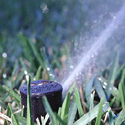Saving Water Using Your Irrigation System
Water is becoming an increasingly scarce natural resource, and it should be used as efficiently as possible. Knowing the amount of water your sprinkler system applies to your lawn is an important step in efficient water use.
What Are Irrigation Zones?
An automatic, underground irrigation system breaks down the job of watering your lawn into smaller areas called "zones." Each of these zones covers a specific area of your yard. Usually there are four or more zones per lawn.
Irrigation systems should be zoned separately for turf and ornamental plants, since water requirements differ for the two. This should be fairly straightforward if you have planting beds.
Ornamental plants should be grouped according to their water requirements: water-loving plants should be grouped separately from drought-tolerant plants. This allows for the proper amount of water to be distributed to the plants as they need it.
What Do I Need for an Automatic Sprinkler System?
An automatic sprinkler system consists of two basic components: a controller and an irrigation shut-off device (a rain sensor or a soil-moisture sensor, more likely the former). A controller is a timing device that controls the frequency and length of time that the system runs. A rain sensor prevents unnecessary irrigation during and soon after a rainfall. Soil-moisture sensors prevent unnecessary irrigation if there is sufficient moisture in the soil.
Rain sensors, which have been required by law on all irrigation systems installed since 1991, are available in several models and are usually connected to the automatic irrigation system remotely or by wiring. The device overrides a scheduled irrigation after a certain amount of rainfall has occurred, by sensing moisture in the soil.
It’s especially important during drought to calibrate your irrigation system and get a rain sensor if your irrigation system doesn’t already have one. They are available at your local home-improvement center.
What Are the Benefits of Irrigation Shut-off Devices?
Irrigation shut-off devices like rain sensors are a low-cost way to save water in your landscape. These devices detect when a certain amount of rain has fallen, and they make sure your automatic irrigation system doesn’t run when it’s not needed.
All new irrigation systems installed since 1991 are required by law to include a rain sensor. Your sensors should always be functioning correctly, so check them regularly.
Rain sensors conserve water, save you money, and reduce wear on your irrigation system. They can also help prevent turf disease and other problems caused by excess moisture.
Read "Residential Irrigation System Rainfall Shutoff Devices" for further information.
1 | 2

More Florida-Friendly Landscaping
- Florida-Friendly Landscapes help create a more sustainable Florida. Find out more.

